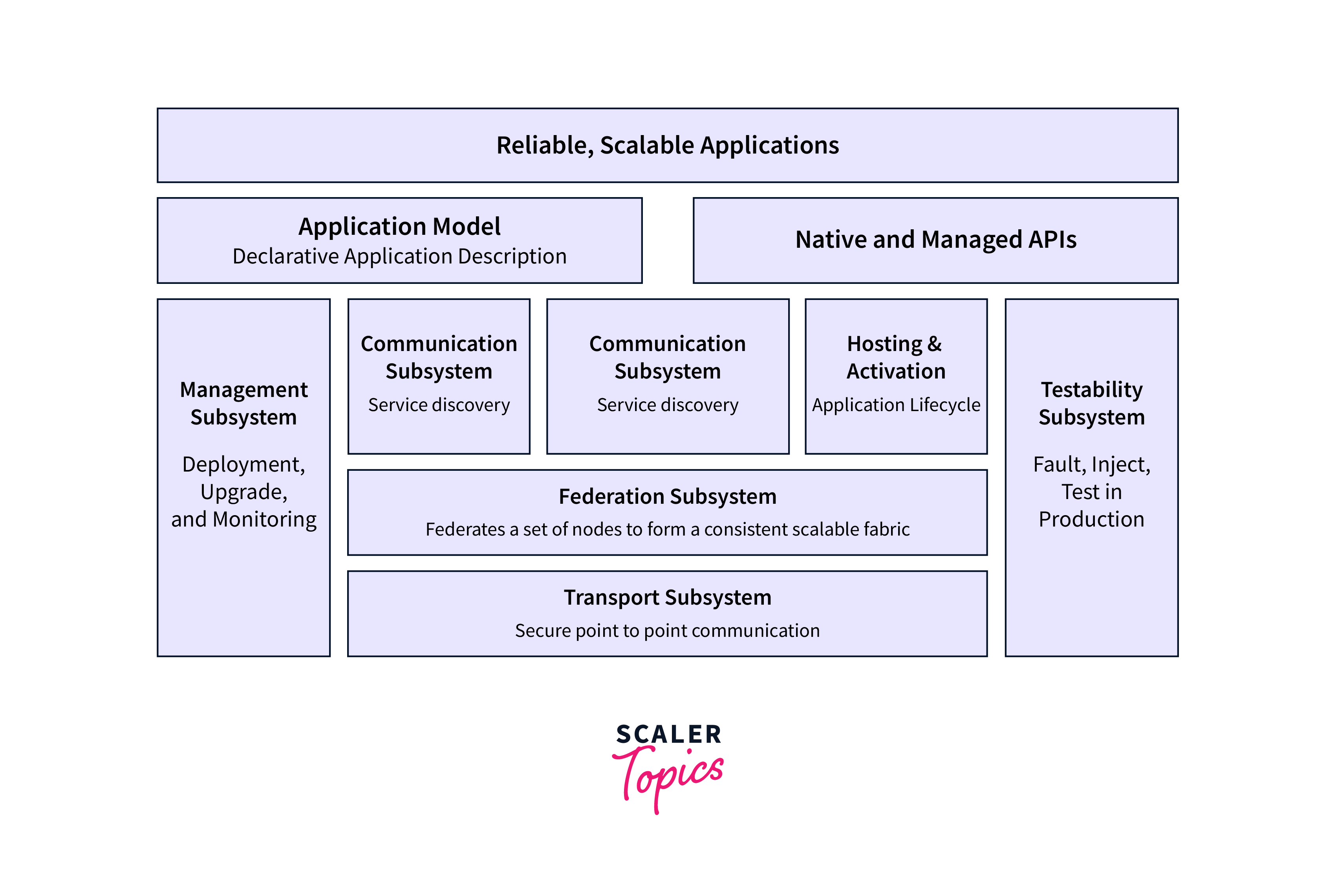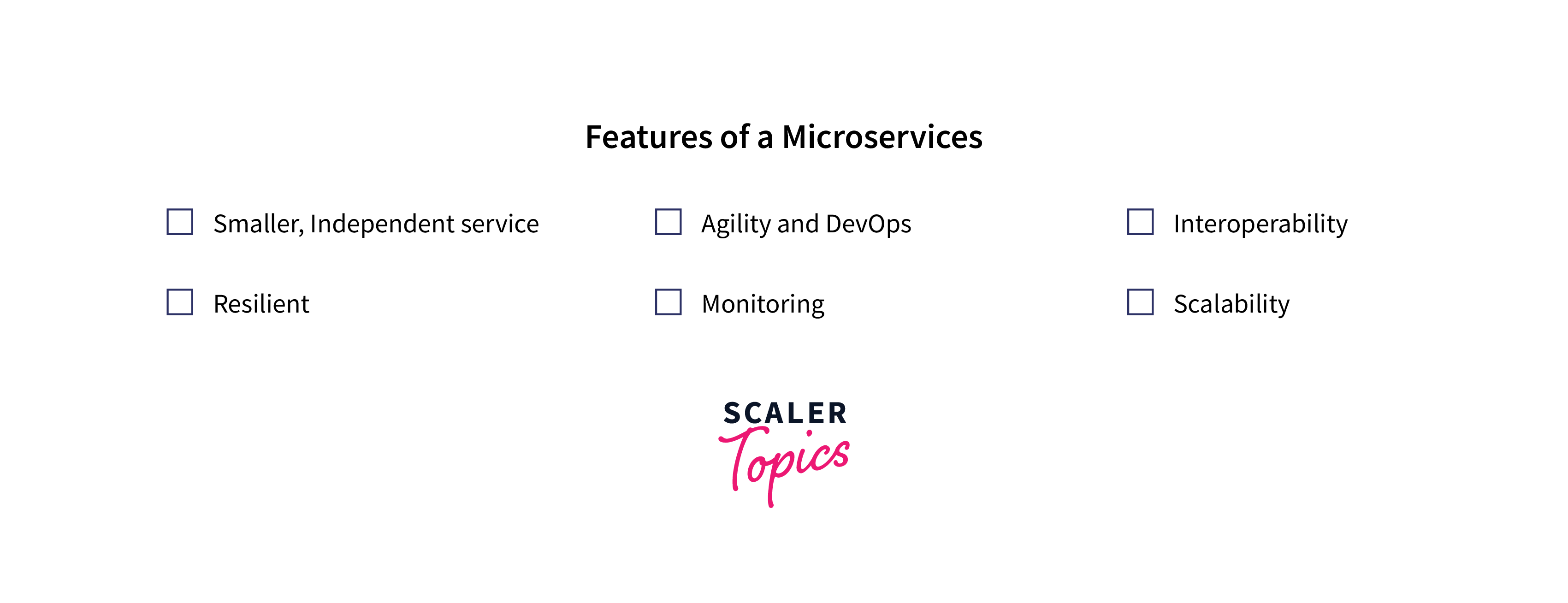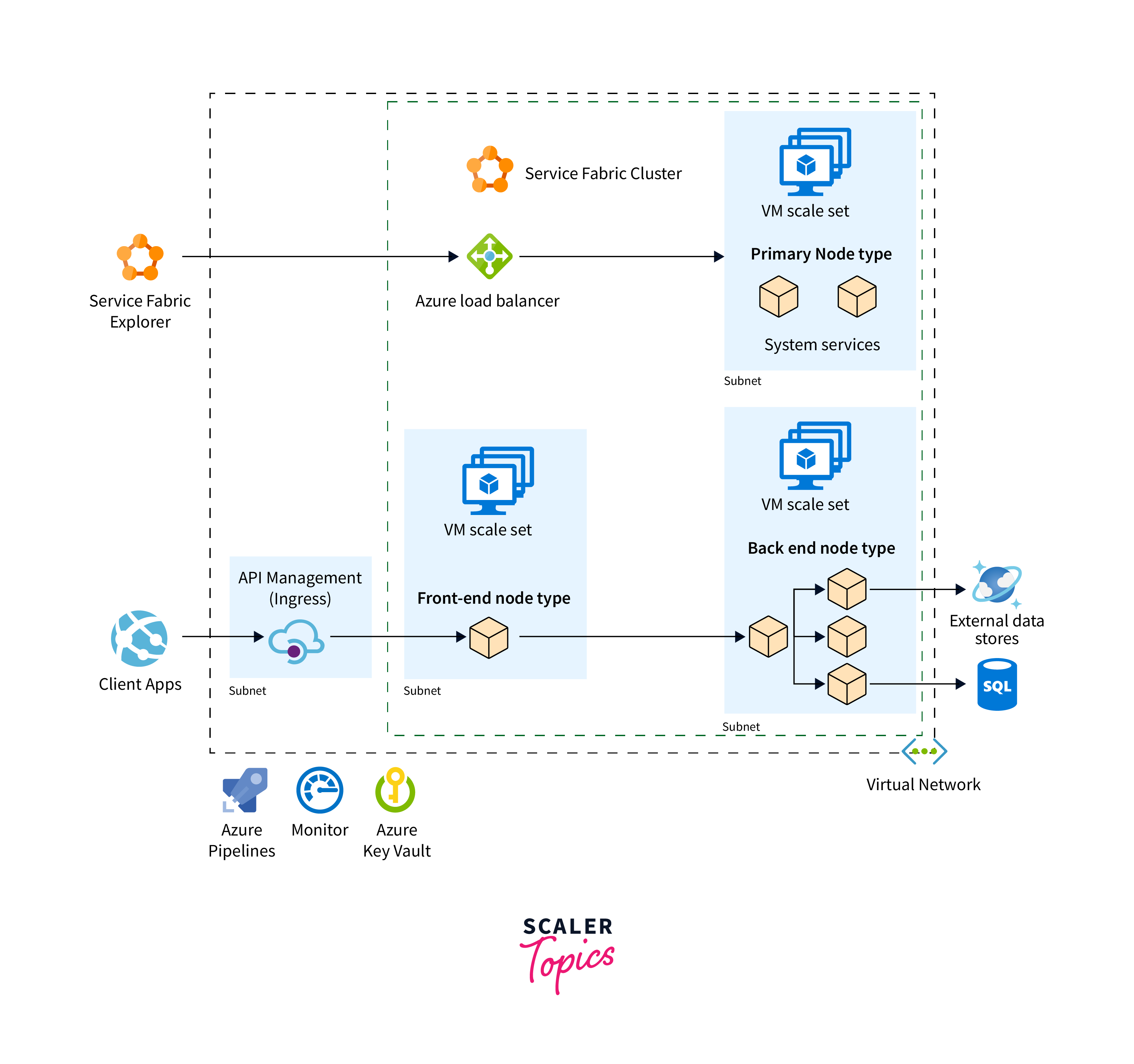Introduction to Azure Service Fabric
Overview
Azure Service Fabric is a distributed systems platform that simplifies the development, deployment, and management of scalable and reliable applications. It abstracts complex infrastructure tasks, allowing developers to focus on coding business logic. Service Fabric offers microservices architecture, automatic scaling, stateful and stateless services, and integrates with Azure services for seamless cloud integration.
Azure Service Fabric Capabilities

Azure Service Fabric is a robust and versatile distributed systems platform offered by Microsoft Azure. It empowers developers to build, deploy, and manage complex and highly available applications with ease. Here are its key capabilities:
-
Microservices Architecture:
Azure Service Fabric enables the development of applications using a microservices architecture. This allows you to break down complex applications into smaller, loosely coupled services that can be developed, deployed, and scaled independently. This is particularly beneficial for applications with various components that can be isolated, maintained, and updated separately.Example:
An e-commerce platform where services for inventory management, payment processing, user authentication, and recommendation engines can be developed and deployed independently, enabling efficient updates and scaling based on demand. -
Stateful and Stateless Services:
Service Fabric supports both stateful and stateless services. Stateful services maintain their internal state, which can be valuable for scenarios where data consistency and durability are critical.Example:
A financial application that tracks account balances and transactions. By using stateful services, the application can ensure that data is not lost in the event of failures and that consistency is maintained across replicas. -
Automatic Scaling:
Service Fabric provides automatic scaling based on resource usage, load, or custom-defined metrics. This helps applications adapt to varying workloads and optimize resource utilization.Example:
A social media platform that experiences high traffic spikes during special events. Service Fabric's automatic scaling can ensure that additional instances of the relevant services are deployed during peak periods and scaled-down during quieter times. -
High Availability and Reliability:
Service Fabric offers built-in mechanisms for handling failures and ensuring high availability. It automatically monitors services and maintains replicas to ensure that applications remain operational even in the face of hardware or software failures.Example:
An online gaming platform where sudden server failures shouldn't disrupt ongoing games. Service Fabric can manage game session replicas and redistribute workloads seamlessly to healthy nodes. -
Health Monitoring and Diagnostics:
Service Fabric provides health monitoring and diagnostics, allowing you to assess the status of services and nodes. It also supports custom health checks and reporting, aiding in proactive issue detection and resolution.Example:
A healthcare application that monitors patient vitals. Service Fabric can continuously monitor the health of the vitals processing service and alert administrators if any anomalies are detected. -
Service Upgrades with Zero Downtime:
Service Fabric supports rolling upgrades, enabling you to update your application without incurring downtime. Old and new versions of services can coexist during the upgrade process, ensuring a smooth transition.Example:
An online booking platform that needs to update its reservation service. Service Fabric can perform rolling upgrades, allowing the platform to continue accepting bookings while the service is being updated. -
Support for Containers:
Service Fabric can host containerized applications, which simplifies the deployment and management of applications built using container technology.Example:
A content management system that uses containerized services for content delivery, image processing, and user authentication. Service Fabric can orchestrate the deployment and scaling of these containerized services. -
Programming Language Flexibility:
Service Fabric supports multiple programming languages, allowing you to build services using languages you're familiar with.Example:
A media streaming platform that has services developed in both C# and Java. Service Fabric can host and manage these services regardless of the programming languages used.
Azure Service Fabric Mesh
Azure Service Fabric Mesh was a Platform-as-a-Service (PaaS) offering from Microsoft Azure that aimed to simplify the deployment and management of containerized applications. Unfortunately, Microsoft announced the retirement of Azure Service Fabric Mesh in 2020, recommending Azure Kubernetes Service (AKS) as an alternative for container orchestration and management.
Key Features:
- Container Orchestration:
Azure Service Fabric Mesh enabled developers to package their applications into Docker-compatible containers, ensuring consistent deployment across various environments. It handled the orchestration of containers, including scaling based on workload demands. - Service Discovery and Load Balancing:
The platform facilitated automatic service discovery and load balancing, efficiently directing incoming requests to the appropriate instances of services, minimizing manual configuration. - Stateless and Stateful Services:
Azure Service Fabric Mesh supported both stateless and stateful services. Stateless services were suited for compute-intensive tasks, while stateful services allowed applications to maintain their state, catering to scenarios requiring data persistence. - Networking:
Integration with Azure Virtual Networks enabled secure communication among services within virtual network boundaries, allowing for hybrid scenarios where on-premises resources could seamlessly interact with Mesh-deployed services. - Monitoring and Diagnostics:
Azure Service Fabric Mesh included comprehensive monitoring and diagnostics capabilities, empowering developers to monitor service health and performance. This facilitated swift issue identification and resolution. - Security and Identity:
Azure Active Directory integration ensured secure authentication and authorization for services, maintaining robust security measures.
Features of a Microservices

-
Service Modularity:
Microservices break down complex applications into smaller, manageable components. Each service focuses on a specific business capability, promoting a clear separation of concerns and easier code maintenance. -
Independence:
Microservices operate independently and communicate through well-defined APIs. This isolation allows teams to develop, deploy, and scale services individually, reducing dependencies and enabling faster development cycles. -
Scalability:
Services can be scaled independently based on demand, optimizing resource usage. This granular scalability ensures efficient allocation of resources to high-traffic components without affecting others. -
Technology Diversity:
Microservices allow the use of different technologies and programming languages for each service. This flexibility enables teams to choose the most appropriate tools for each service's requirements. -
Fault Isolation:
Isolating services minimizes the impact of failures. If one service experiences issues, it doesn't necessarily affect others, leading to improved system reliability and uptime. -
Continuous Deployment:
Microservices support continuous integration and deployment. Teams can update and release services individually without disrupting the entire application, resulting in faster delivery of new features and bug fixes. -
Rapid Development:
Smaller, focused teams can develop and iterate on specific services more quickly, promoting faster innovation and responsiveness to changing business needs. -
Polyglot Persistence:
Microservices can use different databases based on the service's data needs. This approach optimizes data storage for each service and prevents the use of a single monolithic database. -
Resilience and Redundancy:
Microservices can be replicated across multiple instances and even data centers. This redundancy enhances application availability and resilience against failures.
What is a Service Fabric Cluster in Azure?

A Service Fabric cluster in Azure is a managed platform that facilitates the deployment, management, and scaling of highly reliable and scalable microservices-based applications. It's designed to simplify the complexities of building and maintaining distributed systems, allowing developers to focus on writing application logic rather than dealing with intricate infrastructure details.
Key features of a Service Fabric cluster include:
- Distributed Application Hosting:
A Service Fabric cluster acts as a runtime environment for running distributed applications composed of microservices. These microservices can communicate with each other within the cluster, enabling seamless interaction between components. - Automatic Scaling:
The cluster's auto-scaling capabilities allow it to dynamically adjust the number of instances of a microservice-based on workload demands. This ensures efficient resource utilization and responsiveness during traffic spikes. - High Availability:
Service Fabric automatically replicates microservices across multiple nodes in the cluster to ensure high availability. In the event of a node failure, the affected microservices are automatically shifted to healthy nodes, minimizing downtime. - Rolling Upgrades:
Service Fabric supports rolling upgrades, allowing applications to be updated with minimal downtime. It orchestrates the upgrade process, ensuring that both the old and new versions of microservices coexist during the transition. - State Management:
Service Fabric offers support for both stateful and stateless microservices. Stateful microservices can maintain their state, which is managed by the platform for durability and replication. - Service Discovery and Load Balancing:
The cluster provides built-in service discovery and load balancing mechanisms, routing incoming requests to the appropriate instances of microservices without manual configuration. - Health Monitoring and Diagnostics:
Service Fabric offers comprehensive monitoring and diagnostics tools to track the health and performance of microservices. This facilitates rapid issue identification and resolution. - Integration with Azure Services:
Service Fabric can integrate with other Azure services like Azure Active Directory, Azure Monitor, and Azure DevOps, enhancing security, observability, and development workflows.
Azure Kubernetes vs Service Fabric
| Feature | Azure Kubernetes Service (AKS) | Azure Service Fabric |
|---|---|---|
| Container Orchestration | Yes (Kubernetes) | Yes (Custom Platform) |
| Microservices Support | Yes (Stateless & Stateless) | Yes (Stateful & Stateless) |
| Scalability | Horizontal Scaling of Containers | Automatic Scaling |
| Flexibility | Wide Range of Container Runtimes | Supports Diverse Workloads |
| Ecosystem Integration | Azure Services Integration | Azure Services Integration |
| Kubernetes Ecosystem | Yes (Broad Third-Party Ecosystem) | Limited Kubernetes Ecosystem |
| Portability | Portable Across Cloud Providers | Platform-Specific |
| State Management | Stateless & Stateful Services | Stateful Services Supported |
| Automatic Scaling | Yes (Based on Metrics) | Yes |
| High Availability | Yes (Kubernetes Replication) | Yes (Built-in Mechanisms) |
| Application Upgrades | Rolling Upgrades Supported | Rolling Upgrades Supported |
| Health Monitoring | Azure Monitoring Integration | Built-in Monitoring |
| Integration with Azure | Yes (Azure Monitor, DevOps, etc.) | Yes (Azure Services) |
| Complexity | Lower (Kubernetes Management) | Moderate to High |
| Use Cases | Microservices, Stateless Apps | Complex Apps, Stateful |
Azure Service Fabric Architecture
Azure Service Fabric architecture is designed to provide a robust platform for building and deploying complex and highly available applications. It simplifies the development, deployment, and management of distributed systems by abstracting away much of the underlying infrastructure complexity. The architecture is centered around microservices, stateful services, and built-in features that ensure reliability, scalability, and flexibility.
Key Components of Azure Service Fabric Architecture:
- Microservices:
At the core of Service Fabric architecture are microservices – small, independently deployable, and scalable units of an application. Each microservice focuses on a specific business capability, making development and maintenance more manageable. Microservices communicate with each other through well-defined APIs, promoting loose coupling and modularity. - Stateful Services:
Service Fabric supports both stateful and stateless services. Stateful services maintain their state, making them suitable for applications that require data persistence and complex state management. Service Fabric handles the distribution, replication, and synchronization of state across instances. - Service Fabric Cluster:
A Service Fabric cluster consists of a set of machines (nodes) that host the microservices and stateful services. The cluster provides the underlying infrastructure for deploying and managing services. - Reliable Collections:
For stateful services, Service Fabric offers reliable collections – distributed data structures that manage state data with replication and persistence. This enables applications to maintain consistent data across different replicas of a service, even in the face of node failures. - Service Partitioning:
Services in a Service Fabric cluster are divided into partitions. Each partition represents a subset of service instances, allowing for efficient distribution and replication of workloads across nodes. Partitioning enhances scalability and fault tolerance. - Failover and High Availability:
Service Fabric provides automatic failover for both stateful and stateless services. If a node or service instance fails, Service Fabric automatically redistributes the service to healthy nodes, ensuring minimal downtime. - Application Models:
Service Fabric supports multiple application models, such as Reliable Services and Reliable Actors. Reliable Services provides fine-grained control over the infrastructure, while Reliable Actors abstract away infrastructure concerns, making development simpler. - Application Lifecycle Management:
Service Fabric facilitates rolling upgrades, allowing applications to be updated with minimal interruption. It deploys new versions of services incrementally while maintaining backward compatibility, ensuring seamless updates. - Health Monitoring and Diagnostics:
Service Fabric provides tools for monitoring the health and performance of services. It offers insights into the status of services, aiding in identifying and addressing issues quickly.
Conclusion
- Azure Service Fabric & AKS:
Azure Service Fabric and Azure Kubernetes Service (AKS) are powerful Azure services that streamline application deployment, management, and scalability. - Microservices Architecture:
Microservices break down complex applications into smaller, manageable components, enabling agility and independent scaling. - Service Fabric's Custom Platform:
Service Fabric offers a custom platform for building and managing applications, supporting stateful and stateless services, and ensuring high availability. - AKS & Kubernetes:
AKS leverages Kubernetes, an open-source container orchestration platform, for managing containerized applications. - Flexibility & Portability:
AKS supports a wide range of containers and tools, promoting flexibility and portability across environments. - Complexity Management:
AKS abstracts much of Kubernetes' complexity while providing access to its rich ecosystem and Kubernetes-native features. - Stateful Services:
Service Fabric excels in stateful service management, with built-in mechanisms for state replication, distribution, and persistence. - Application Upgrades:
Both platforms support rolling upgrades for seamless application updates, minimizing downtime. - Integration with Azure:
Both services integrate with Azure's ecosystem, offering tools like Azure Monitor and Azure Active Directory for enhanced application management.
